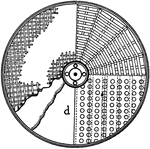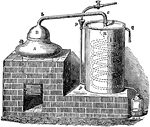Clipart tagged: ‘purify’

Chlorination Barrel
The chlorination process in gold extraction employs large vats or revolving barrels, the material inside…

Chlorination Barrel (End Section)
The chlorination process in gold extraction employs large vats or revolving barrels, the material inside…

Cyanide Leaching Tank (Gold Extraction)
In the gold extraction process, finely crushed ores are leached in vats with a very diluted solution…

Still
"Impure water is vaporized in the boiler, A. It travels to the vat and down pipe R where it condenses…